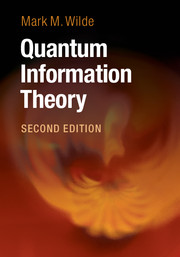Book contents
- Frontmatter
- Contents
- Preface to the Second Edition
- Preface to the First Edition
- How To Use This Book
- Part I Introduction
- Part II The Quantum Theory
- Part III Unit Quantum Protocols
- Part IV Tools of Quantum Shannon Theory
- Part V Noiseless Quantum Shannon Theory
- Part VI Noisy Quantum Shannon Theory
- Introduction
- 20 Classical Communication
- 21 Entanglement-Assisted Classical Communication
- 22 Coherent Communication with Noisy Resources
- 23 Private Classical Communication
- 24 Quantum Communication
- 25 Trading Resources for Communication
- 26 Summary and Outlook
- Appendix A Supplementary Results
- Appendix B Unique Linear Extension of a Quantum Physical Evolution
- References
- Index
Introduction
from Part VI - Noisy Quantum Shannon Theory
Published online by Cambridge University Press: 16 February 2017
- Frontmatter
- Contents
- Preface to the Second Edition
- Preface to the First Edition
- How To Use This Book
- Part I Introduction
- Part II The Quantum Theory
- Part III Unit Quantum Protocols
- Part IV Tools of Quantum Shannon Theory
- Part V Noiseless Quantum Shannon Theory
- Part VI Noisy Quantum Shannon Theory
- Introduction
- 20 Classical Communication
- 21 Entanglement-Assisted Classical Communication
- 22 Coherent Communication with Noisy Resources
- 23 Private Classical Communication
- 24 Quantum Communication
- 25 Trading Resources for Communication
- 26 Summary and Outlook
- Appendix A Supplementary Results
- Appendix B Unique Linear Extension of a Quantum Physical Evolution
- References
- Index
Summary
Before quantum information became an established discipline, John R. Pierce issued the following quip at the end of his 1973 retrospective article on the history of information theory (Pierce, 1973):
“I think that I have never met a physicist who understood information theory. I wish that physicists would stop talking about reformulating information theory and would give us a general expression for the capacity of a channel with quantum effects taken into account rather than a number of special cases.”
Since the publication of Pierce's article, we have learned much more about quantum mechanics and information theory than he might have imagined at the time, but we have also realized that there is much more to discover. In spite of all that we have learned, we still unfortunately have not been able to address Pierce's concern in the above quote in full generality.
The most basic question that we could ask in quantum Shannon theory (and the one with which Pierce was concerned) is how much classical information a sender can transmit to a receiver by exploiting a quantum channel. We have determined many special cases of quantum channels for which we do know their classical capacities, but we also now know that this most basic question is still wide open in the general case.
What Pierce might not have imagined at the time is that a quantum channel has a much larger variety of capacities than does a classical channel. For example, we might wish to determine the classical capacity of a quantum channel assisted by entanglement shared between the sender and receiver. We have seen that in the simplest of cases, such as the noiseless qubit channel, shared entanglement boosts the classical capacity up to two bits, and we now refer to this phenomenon as the super-dense coding effect (see Chapter 6). Interestingly, the entanglementassisted capacity of a quantum channel is one of the few scenarios where we can claim to have a complete understanding of the channel's transmission capabilities. From the results regarding the entanglement-assisted capacity, we have learned that shared entanglement is often a “friend” because it tends to simplify results in both quantum Shannon theory and other subfields of quantum information science.
- Type
- Chapter
- Information
- Quantum Information Theory , pp. 539 - 540Publisher: Cambridge University PressPrint publication year: 2017



